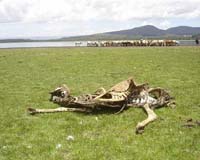 |
Paris, France (ESA) Jan 25, 2010 On 2 January, Mount Nyamulagira in the Democratic Republic of Congo erupted, spewing lava from its southern flank and raising concerns that the 100 000 people in the town of Sake could be under threat. Fears were also triggered in Goma as rumours circulated that an eruption was imminent at the nearby Nyiragongo volcano, which devastated the city in 2002. Following the eruption, scientists and local authorities have been using a long series of space images from ESA's Envisat, together with seismic and helicopter data, to monitor the situation and calm fears of the local population. Dr Nicolas d'Oreye of GORISK, which is in Congo assisting the Goma Volcano Observatory to collect and process satellite observations and field data, said the satellite images are very useful for managing the crisis. "As well as helping to validate information from different datasets, the satellite images are providing invaluable information about the situation, such as the details about the lava flow and the fact that the Nyiragongo volcano is not showing any signs of abnormal activity. "This has been of great importance for the local authorities and the Goma Volcano Observatory, who are holding daily crisis meetings, to reassure the local population and humanitarian agencies that Nyiragongo will be unaffected by the eruption of Nyamulagira." Goma, the capital of the North Kivu province, is situated along the southern margin of the lava fields from these volcanoes. Lava from the Nyamulagira (height 3058 m) eruption has been flowing in a direction south and southwest of the volcano, raising concerns that lava could cover the Goma and Sake road within weeks, causing widespread chaos and threatening the local economy. "Lava flows from Nyamulagira are usually not a direct threat for the population and the infrastructure except when it develops southwards, as it is in this case," explained Dr d'Oreye, a senior scientist at the Geophysics/Astrophysics Department of the National Museum of Natural History in Luxembourg. "In this situation, it is crucial to monitor the flow size, direction and speed for the authorities to be able to make timely decisions." Lava flows can be mapped by comparing satellite radar images acquired before and after the eruption. In the images, old lava appears bright white. If an area appears white in before images and black in after images, then the ground has changed between acquisitions by the flow of new lava. By comparing images acquired over the area before and after the eruption by the Advanced Synthetic Aperture Radar (ASAR) on Envisat, the GORISK team was able to detect a lava flow in the main caldera and one of the paths of the flows. To learn how the ground deformed during the volcanic eruption, the team used a technique called 'SAR interferometry', or InSAR, to construct an 'interferogram' image by analysing the differences between two radar signals taken over the same area on Earth at different times. The first interferogram processed after the onset of the eruption, based on data from 7 December 2009 and 8 January 2010, shows the ground deformation due to the eruption. A complete set of coloured bands, called 'fringes', represents ground movement relative to the satellite of 2.8 cm in the case of Envisat's ASAR. The InSAR technique was also applied to data over Mount Nyiragongo to determine whether there were any signs of activity at the volcano. In order to evaluate the level of risk and increase their knowledge of volcanoes, volcanologists need continuous data over long periods. In some cases, only a satellite is capable of providing this, because some areas are inaccessible or too dangerous to be approached. For instance, to reach Mount Nyamulagira by ground scientists would have to travel through dense tropical forests in a region where rebel forces are present. Envisat can supply this much-needed information and provide accurate maps of areas at risk. Continuously gathered satellite data can be used to assess risk and detect the slight signs of change that may foretell an eruption. The GORISK project, funded by the Belgian Science Policy Office and the National Research Fund of Luxembourg, aims to improve and implement techniques dedicated to studying and monitoring the Nyamilagira and Nyiragongo volcanoes through space- and ground-based observations. "This eruption is a good exercise for a potential eruption of Nyiragongo, which is the major concern for the city of Goma and its 800 000 inhabitants," Dr d'Oreye said.
Share This Article With Planet Earth
Related Links Envisat Earth Observation News - Suppiliers, Technology and Application
 Kenyan herders get satellite livestock insurance
Kenyan herders get satellite livestock insuranceNairobi (AFP) Jan 21, 2010 Researchers on Friday launched an insurance scheme for Kenyan herders using satellite images to provide broader and fairer compensation for livestock losses. Launched in northern Kenya's pastoralist -- or livestock raising -- Marsabit region, the Index-Based Livestock Insurance (IBLI) uses vegetation images to estimate cattle mortality as a function of forage loss. Project leader Andrew ... read more |
|
| The content herein, unless otherwise known to be public domain, are Copyright 1995-2009 - SpaceDaily. AFP and UPI Wire Stories are copyright Agence France-Presse and United Press International. ESA Portal Reports are copyright European Space Agency. All NASA sourced material is public domain. Additional copyrights may apply in whole or part to other bona fide parties. Advertising does not imply endorsement,agreement or approval of any opinions, statements or information provided by SpaceDaily on any Web page published or hosted by SpaceDaily. Privacy Statement |